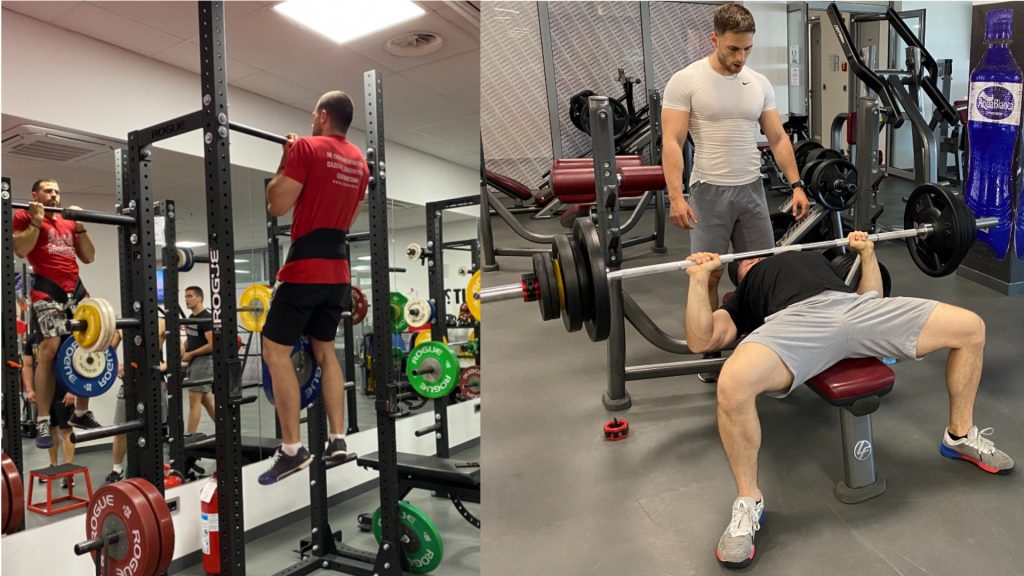Every time I don’t train at my gym, I face the most common situation on commercial gyms, and it is that people, even with personal trainers, simply take one piece of equipment, perform one set, rest for a certain number of minutes while sitting on the very same piece of equipment, and the situation continues until all planned sets are finished. This is known as straight sets.
And even though this type of training can produce some results when compared to not training, it is my opinion that there are more efficient ways to train and to produce eye-opening results. Another negative part about this form of training is that the person simply monopolizes that piece of equipment, and the rest of the people at the gym simply have to wait until that person finishes, because normally they are not willing to share.
And when I mentioned more efficient ways to train on the previous paragraph, I was actually referring to the use of supersets, and in this occasion, I’ll talk about agonist-antagonist supersets.
What is a superset?
A superset refers to perform one set of exercise 1, rest as prescribed, do one set of exercise 2, rest as prescribed, and then go back to exercise 1 until completing all the sets for both exercises.
In particular, when it is referred as an agonist-antagonist superset, exercise 1 will be the agonist, for example elbow flexors i.e., biceps, and the exercise 2 will be its antagonist, in this case, elbow extensors i.e., triceps. There are plenty of applications in the whole body, like wrist extensors and flexors, shoulders extensors and flexors, knee extensors and flexors, ankle extensors and flexors, etc., so basically, you’ll be training muscles in opposite muscle patterns, like squats and leg curls, chin-ups and shoulder presses, rows and bench presses, etc.
What are the advantages of using agonist-antagonist supersets?
-
Perform more work in the training session:
Let’s say you are training under relative strength parameters and you need full recovery between sets. That means that your rest intervals should be 4 – 5 minutes between sets of the same muscle group. If you are just doing, let’s say chin-ups, you’ll be able to perform about 12 sets in 60 minutes. On the other hand, if you superset chin-ups with overhead presses, the rest interval can be decreased to 2 minutes, thus doubling the amount of sets performed in the training session, being 24 total sets; 12 for chin-ups and 12 for overhead presses.
The same can be applied to the training of different strength qualities like functional hypertrophy, hypertrophy and strength endurance.
-
Decrease the length of the rest intervals:
As shown in the previous point, instead of resting 4 minutes between sets of chin-ups, you can rest 2 minutes if you superset them with overhead presses. And you might be wondering if that decrease in the rest interval can lead to a subsequent decrease in performance, and the opposite is actually true; the performance normally increases. Let me explain. In order to be able to contract a muscle, its antagonist must relax, otherwise there won’t be movement of the joint (try to contract the biceps while contracting the triceps at the same time…). This means that when you perform this type of supersets, you are actually making sure that you are relaxing the agonist while training the antagonist and vice versa, which leads to higher levels of fiber recruitment in the upcoming sets, and this leads me to my next point.
-
Higher motor unit activation
A motor unit is a motor neuron together with the muscle fibers on which it acts. Due to the effect of relaxation and the obvious stretching of the antagonist while performing the work for the agonist, experience and science had shown that the trainee can achieve a higher motor unit activation. Also, the fact of activating different motor units at different times, could create a higher activation of the central nervous system, also leading to a higher motor unit activation. A study showed that the power output was higher when using an agonist-antagonist superset configuration, compared to straight sets.
-
Diminishing of the drop-off index
The drop-off index is a measure of performance reduction during training and of course, we want to minimize it or fully avoid it, but nevertheless it sets in as a result of exhaustion. Training using agonist-antagonist supersets have proven to produce lower drop-off indexes when compared to straight sets. The mechanisms are not fully explained by science, but most probably has to do with what I explained on point 3.
-
Higher frequency of training for the same muscle group
The usual norm of training with straight sets dictates that you train the same muscle group usually every seven days. As you can pack 2 different muscle groups in the same training session when performing agonist-antagonist supersets, you will be able to train the same muscle groups, depending on your recovery capabilities, every 4 to 5 days. This implies a higher frequency of training for those muscle groups, and we know that higher frequencies of training lead to better and faster results.
-
Higher levels of hormones
Research from 1897 to date has proven that higher volume of training leads to a higher secretion of anabolic hormones. When using agonist-antagonist supersets, you can even double the volume of a training session compared to straight sets, as explained on point 1. This higher amount of volume can lead to a higher endogenous production of anabolic hormones like testosterone and growth hormone, which in turn will lead to better results from your training.
-
Increased metabolism
The fact that lifting weights elevates the metabolism has been well studied by science. It is also clear that there is a direct correlation between the amount muscle mass trained and the degree of metabolism increase from lifting weights. This means that you won’t get the same effect in terms of metabolism activation if you train forearms vs. training legs. Using agonis-antagonist supersets ensures the use of more muscle mass per training session, which leads to a higher increase in metabolism, compared to straight sets. This in turn is conductive to an improved body composition, which is a determinant factor when measuring results.
If for whatever reason you are worried that by training using agonist-antagonist superset, you won’t be able to give a high amount of volume to a specific muscle group, think about it twice. I have been able to do between 21 and 26 sets per muscle group in 55 minutes. It is just a matter of proper program design.
Implementing this training modality in a commercial gym is not hard or complicated. You just have to let know the person that is about to take one of the stations you are using, nice and politely, that you are performing supersets and that you’ll get back to that station in a certain number of minutes.
And on a final note, Arnold Schwarzenegger was a big proponent of the use of supersets and his results spoke by themselves.
Implement the agonist-antagonist superset on your training and enjoy all the benefits.
Coach Carlos Castro

